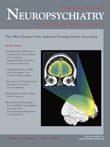REGULARFull Access
Published Online:1 Jan 2009
- Cited by
- Psychiatric Annals, Vol. 48, No. 12
- 10 February 2016 | Acta Psychiatrica Scandinavica, Vol. 133, No. 5
- Harvard Review of Psychiatry, Vol. 23, No. 1
- 26 February 2014 | Acta Psychiatrica Scandinavica, Vol. 130, No. 3
- 3 July 2012 | Early Intervention in Psychiatry, Vol. 7, No. 3
- Journal of Nervous & Mental Disease, Vol. 201, No. 1
Metrics
History
Published online 1 January 2009
Published in print 1 January 2009



